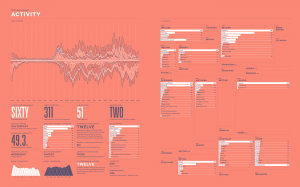I misspoke in class: Nicholas Felton was the person I was thinking of. I saw him speak earlier this year at the games & culture conference two5six. He is a graphic designer, and has achieved some notice for issuing yearly “reports” containing his personal data.
He has also designed a website that enables others to track and interact with their own data. “Begin collecting and exploring your data to reveal the bigger picture,” copy on the site implores. Curiously, when a group of us asked Felton about deploying this kind of data collection toward something like “accountability reports” for governments or other entities, he resisted wholesale. For him this was about quantifying the self, not the other. It was personal.
How big does the picture get when quantifying yourself?
McCarthy and Wright open an analysis of technology at the level of personal experience, or feeling. This was somewhat revelatory for me—and surprisingly novel given my own preoccupation with couching terms according to relational perspectives. I think it duly emphasized in their writing. There is indeed something personal in my interaction with my technologies, even (especially?) when I’m absorbed in public. What is that feeling?
It’s like I’m thinking private thoughts…on my phone.




1 response so far ↓
John Giunta // Nov 12th 2013 at 10:44 pm
We (still) tend to draw distinct lines between our technology and our selves (bodies, brains, floating consciousnesses, etc.) even as we become more absorbed in, reliant on, and, in some of the examples provided in this unit, plugged into our machines. I’m wondering if the advances in this super interesting pursuit of the quantified self will make those distinctions stronger, or start to blur those lines beyond recognition? It seems the raw data produced by these kinds of self-testing would further an understanding of the human as machine, made from parts that can be studied, cataloged, fine tuned, and upgraded.